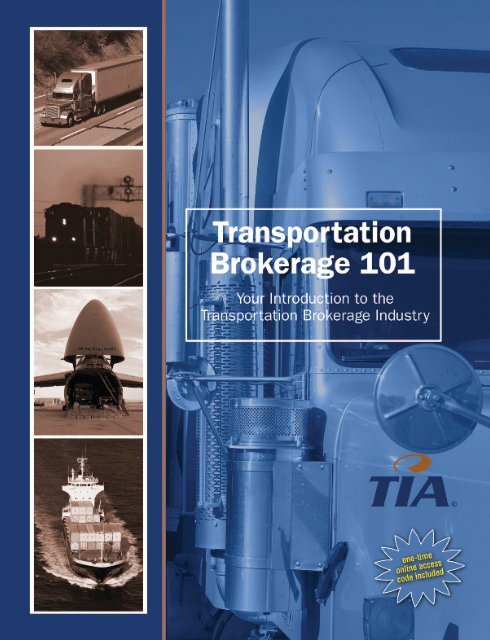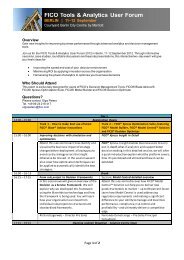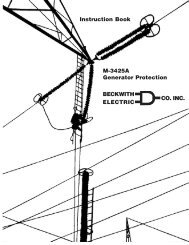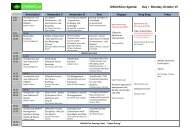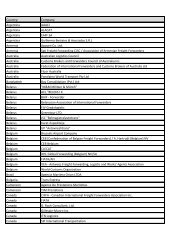TIA: Transportation Brokerage 101 Web Sampler
TIA: Transportation Brokerage 101 Web Sampler
TIA: Transportation Brokerage 101 Web Sampler
Create successful ePaper yourself
Turn your PDF publications into a flip-book with our unique Google optimized e-Paper software.
The attached materials are the property of <strong>TIA</strong>, which owns all, right, title and interest, including<br />
international copyrights, in and to them. You may review them for the purpose of evaluating a potential<br />
business relationship, but you are not permitted to use them for any other purpose. Specifically, you may<br />
not transfer, sell, rent, license, copy, publish, distribute, display, perform, adapt, abridge, combine with<br />
any other work, or offer, make, or have made any work, product or service derived from any part of the<br />
materials.<br />
(C) 2009 <strong>Transportation</strong> Intermediaries Association, Inc.
The Broker’s Job<br />
While all brokers, customers, and carriers have differences in<br />
their policies and procedures, most should have the same<br />
basic principles. Just like many other industries, there is not<br />
necessarily one standard format or set of procedures, but<br />
rather generally accepted guidelines to follow. Frequently,<br />
the basic principles practiced within an organization and<br />
also generally in an industry become the normal format for<br />
operations over a period of time. A “generally accepted<br />
guideline” ultimately becomes the basis for a standard or<br />
expected practice when a professional group or regulating<br />
agency attempts to makes a policy or requirement. These<br />
generally accepted industry guidelines refer to the concept<br />
that no true, concrete, and legislated standard exists; however,<br />
most parties involved agree that there are certain guidelines<br />
that should be followed when conducting business in<br />
the industry.<br />
We are using the term “customer” in this chapter as it<br />
covers all shippers, consignees, distributors and “middlemen”<br />
and as well as others who control the movement of<br />
freight. Every firm, other than the smallest retail service<br />
business, will need some type of products to conduct their<br />
business. Look around as you do your shopping. All this has<br />
to get here from somewhere else and it should be looked on<br />
a host of opportunities.<br />
This concept is important to remember when dealing<br />
with anyone in the industry, including brokers, customers,<br />
agents, regulatory agencies or vendors. You want to get the<br />
best deal without trying to shatter the boundaries of standard,<br />
accepted business practices. Failure to adhere to the<br />
35<br />
Chapter<br />
8<br />
standard policies and procedures may result in a situation<br />
where you cannot compete with the competition and/or<br />
attract and retain customers. The general business guidelines<br />
discussed above should be followed not only because they<br />
are generally accepted guidelines but, perhaps more importantly,<br />
because experience shows that these particular principles<br />
and processes tend to provide the best results.<br />
These guidelines should be kept in mind when dealing<br />
with negotiations and contracts. The representative of the<br />
broker should exercise all of the selling points possible with<br />
regards to services provided and the ability to handle the<br />
demands associated with each load. This allows the broker<br />
representative to adhere to the generally accepted guidelines<br />
and perhaps have extra negotiating points to convince customers<br />
to agree to what is to be done “over and above” the<br />
generally accepted minimum guidelines. As your brokerage<br />
consistently provides high-quality service, the professionalism<br />
displayed is likely to result in a solid business relationship<br />
that might justify future rate increases. This method<br />
allows the broker to achieve results above the typical boundaries<br />
of the industry, something most successful brokers will<br />
consistently try to accomplish.<br />
If the broker consistently earns the respect of customers<br />
with regards to the ability of its brokerage to deliver highquality<br />
services, it will find that customers will tend to be<br />
loyal to excellent service. Excellent service helps the customer<br />
to cut its costs, providing a benefit to its organization.<br />
Therefore, the broker is providing a value-added<br />
service to its customer, which is extremely important to the
36 Chapter 8 The Broker’s Job<br />
professional health of anyone participating in the brokerage<br />
business.<br />
One of the best negotiation and sales tools any representative<br />
of a broker has is to be able to show the customer<br />
(customer) that the broker has the resources necessary to<br />
accomplish value-added benefits on behalf of the customer.<br />
The broker must be able to solve problems efficiently and<br />
effectively and simultaneously multitasking to serve other<br />
customers at the same time.<br />
Membership in <strong>TIA</strong>, which commits a broker to higher<br />
ethical standards, is an excellent sales and marketing tool.<br />
There are three basic groups that you, as a broker or<br />
brokerage representative, will be targeting in your marketing<br />
and sales efforts. These three groups are customers or consignees,<br />
carriers, and other agents or sales representatives.,<br />
Each representative needs to learn what each potential “customer”<br />
is looking for in a broker in order to achieve success.<br />
Once this is identified, you will be able to successfully market<br />
your value-added services and capabilities to them. To<br />
enhance your chances of success as a broker, you need to<br />
offer value-added services that the customer may not be able<br />
to achieve when purchasing transportation on its own, or<br />
from the carriers it is currently using to transport its cargo.<br />
Success Rule<br />
You must be resourceful.<br />
By adding these types of value-added services to the proposal,<br />
you will be able to sell your services. Being able to<br />
offer a broad range of services targeted toward the key needs<br />
of each customer allows you to try to compete on a variety<br />
of variables as opposed to simply comparing rates to other<br />
brokers and carriers.<br />
Finding a Customer and Freight<br />
While finding a customer can sometimes be difficult, getting<br />
them to use your services may not be as difficult as the<br />
overall execution of transporting the load. Ultimately, finding<br />
them may be the simple part of the equation!<br />
As the broker makes strategic decisions such as what<br />
region to target to find customers, some basic, key questions<br />
such as the following may aid the broker when making<br />
strategic customer identification decisions:<br />
Q. Where are the trailers?<br />
A. Anywhere that you see trailers is a potential customer.<br />
Q. Did you look in the yellow pages?<br />
A. Anything that is sold or manufactured (not a service<br />
A broker, agent, or sales representative must be a problem solver and be resourceful enough to develop<br />
solutions for its customer’s problems.<br />
When you arrange for freight transportation, the customer and carrier both expect that you will<br />
find a solution to almost any problem that arises. This means being a resourceful problem solver. If<br />
the carrier used to transport a load has a vehicle failure and cannot find a repair shop located close<br />
to the incident, you as the broker have two options:<br />
1. Find another carrier AND a lumper service (individual(s) who loads and/or unloads trailers) to offload the<br />
trailer that had a vehicle failure and transfer the cargo to another carrier; or<br />
2. Find a repair shop where the carrier can pay for services.<br />
Being resourceful oftentimes means having a plan to solve a problem or series of problems. Being<br />
resourceful means you do not generally tell a customer or a carrier that you cannot be of help or<br />
that you do not know what to do on their behalf. The successful alternative is to find a suitable<br />
solution very rapidly. Generally, it is the customer and carrier that are involved in an incident.<br />
Unfortunately you, as the broker, are the one who stands to lose business, not them.<br />
Being a broker can be a very complex job but if you have the knowledge and skills necessary, it can<br />
be a very profitable and exciting career. It is hoped this text will help to give the reader the skills and<br />
knowledge necessary to achieve success when performing the job of a broker in a professional and<br />
successful manner.
Scenario<br />
offered) is a potential customer. You can order state manufacturing<br />
guides.<br />
Q. Where are the carriers I see in this area going (what is<br />
their destination)?<br />
A. They are going to a customer facility or a receiver’s facility.<br />
Q. Does a receiver ship as well?<br />
A. Unless it is a retailer, whatever it receives eventually gets<br />
shipped back out in some form.<br />
It can be that easy to find a customer! A customer who has<br />
the trailers of a particular carrier dropped off at its facility<br />
probably has large amounts of freight to be moved. However,<br />
using multiple carriers can be time consuming and<br />
confusing for the customer’s traffic department. Therefore,<br />
you must analyze the customer and find all of the key variables<br />
of importance to the customer and use those issues as<br />
the basis for your marketing strategy to that particular customer.<br />
Those who are observant and consistently review<br />
Chapter 8 The Broker’s Job 37<br />
Your carrier has arrived at the consignee, and it will not unload the trailer. The consignee tells the<br />
driver that this type of situation is “always a drop trailer situation at unload and it will take 5 days<br />
to unload.” The driver calls the carrier, who subsequently calls you.<br />
Question: What could have prevented this situation? How can this situation be fixed?<br />
Answer: Remember to look at it from all perspectives.<br />
The carrier wants to charge the regular rate at 450 miles per day, which is $1.10 per mile for 450<br />
miles, or $495.00 per day.<br />
A. The customer just wants the cargo off of its dock. It usually has no control over the receiver.<br />
B. The receiver wants to pay nothing, since this is its normal procedure. The receiver will also note that if you<br />
had called for a delivery appointment, you would have been told it was a drop trailer.<br />
C. The broker simply wants to keep the $495.00 per day.<br />
To fix this problem, you may have a couple of options as discussed below. First, you can contact the<br />
receiver to see what you can work out to get the trailer unloaded as quickly as possible. Second, you<br />
can then contact the carrier to see what you can work out to pay the driver layover until the consignee<br />
unloads. If done with professionalism and a lot of additional effort, these types of situations<br />
can usually be worked through. While the end result may not be an ideal situation, proving that<br />
you, as the broker, can serve as a problem solver for the carrier and customer will typically yield<br />
positive results. Be prepared with your information and manage it well in an attempt to enhance<br />
your ability to serve as a successful problem solver. Misinformation and small mistakes such as not<br />
setting a delivery appointment or asking about a drop trailer situation could cost thousands of dollars if<br />
not handled properly.<br />
their business plan may realize that the plan may contain a<br />
list of possible marketing ideas for customers and a list of<br />
target customers (see sample, Appendix 2).<br />
A customer with trailers that are staged at its facility has<br />
usually requested this service of the carrier. In these types of<br />
situations, the carrier will keep one or more empty trailers in<br />
the customer’s yard. This benefits the customer by allowing<br />
it to have empty trailer(s) available 24 hours a day. A yard<br />
manager can hook up to an empty trailer, place it at a dock,<br />
and allow the customer to load the trailer at its convenience.<br />
As for a carrier, a trailer staged at the customer’s location<br />
means, for example, that a load scheduled to be delivered<br />
on Friday can be preloaded on Monday. Nothing is<br />
required of the carrier until the time to move the load on<br />
Wednesday. This type of process gives the broker more<br />
assurance that all of the loads available from the customer<br />
can be picked up. A carrier that is willing to drop a trailer<br />
can be a wonderful asset to both the customer and the broker.<br />
In addition to the above, if the carrier drops its trailer at<br />
the customer’s location and it is subsequently loaded, the
38 Chapter 8 The Broker’s Job<br />
carrier is then responsible for covering the shipment. Once<br />
the shipment is on the carrier’s trailer, it does not get much<br />
easier for the broker. Below is a sample scenario designed to<br />
illustrate a typical customer–carrier–broker relationship.<br />
When scenarios like the above arise, there are some brokers<br />
who believe that raising voices, intimidation, or other<br />
“scare” tactics are the way to win. Oftentimes this does not<br />
achieve a positive immediate result and usually negatively<br />
impacts the long-term success and profitability of the brokerage.<br />
When dealing with these types of business situations,<br />
it is very important to always conduct yourself in a<br />
professional manner. Always contact the customer regarding<br />
the pickup for every load and the consignee to schedule<br />
unloading. Even if the regular schedule is based on a firstcome,<br />
first-served basis, be sure the carrier is aware of this.<br />
Once you have located a potential customer, conduct<br />
some research to find out more about the customer and its<br />
expectations. There are many ways to conduct research<br />
about a particular customer. For example, you can look on<br />
the Internet for a company <strong>Web</strong> page? If so, you may find<br />
contact information for the traffic or shipping department.<br />
You may also want to review the local Chamber of Commerce<br />
<strong>Web</strong> page, which may allow you to obtain a description<br />
of the customer’s business and relevant contact<br />
information. Networking with people who may know about<br />
the customer can also be a successful way to conduct<br />
research on the customer. These types of research can help<br />
you find out what the customer is looking for in terms of<br />
transportation services. Then you can contact the customer<br />
by phone, fax, personal visit, mail, or other. Oftentimes, in<br />
the current operating environment, phone, e-mail, and personal<br />
visits are all acceptable and when combined together<br />
can result in communicating a very effective message to the<br />
customer.<br />
Once contact has been made with the customer, the<br />
broker needs to determine if the customer has any special<br />
requirements that must be met when contracting with it to<br />
provide shipping services. It is necessary to find out all of<br />
the key requirements necessary to successfully obtain the<br />
cargo transportation business of the customer. If the customer<br />
Success Rule<br />
Always keep your professionalism.<br />
has no special shipping requirements, the broker can prepare<br />
a proposal and attempt to work something out with the customer.<br />
If the customer does have special requirements, these<br />
special requirements must be addressed in the proposal presented<br />
to the customer.<br />
Oftentimes it is not beneficial to reinvent the wheel.<br />
However, if you find a customer (or carrier) that has not<br />
previously tried using a broker, find out how its operation<br />
works and show it in writing how the operation would be<br />
improved if you were involved. For example, you can illustrate<br />
what the costs and benefits are to the customer if it<br />
uses your brokerage services? You must also analyze how<br />
much you would charge to move the load. One way to gain<br />
insight into the rate you would charge could be to run a trial<br />
search on an Internet-based freight board, look at load densities,<br />
and quote your rate based on the information provided.<br />
If you can cover the load for a lower price than the<br />
customer and offer value-added services, the sale can be relatively<br />
easy. The customer not only avoids having to arrange<br />
for cargo transportation but also saves money by allowing<br />
you as the broker to move the load for it.<br />
The broker, on the other hand, will have to prove itself<br />
to the customer (and perhaps the carrier) by providing a<br />
high level of customer service. If the broker can get the loads<br />
successfully transported for less than the rate that was<br />
quoted, the broker also achieves success. Make sure before<br />
you start the process of getting contracts signed, paperwork<br />
exchanged, and rates negotiated that you will be able to<br />
arrange to successfully transport the freight. If you cannot<br />
perform, the customer is not likely to use your services<br />
again.<br />
For example, you have a customer that pays $1,000.00<br />
for a load (revenue). You contract with a carrier to haul the<br />
load for $900.00. Your net profit is $100.00. Make sure you<br />
will be able to have a net profit and not a net loss.<br />
If a potential customer offers a contract that is comparable<br />
to the average freight you are moving now (comparing<br />
apples to apples), then you can look at the average profit you<br />
make per load (see Tables 8-1 through 8-3, next page). You<br />
can then presume that with all things being equal, you can<br />
In the scenario above, it might be very easy for some to lose his or her cool. Just remember that if<br />
you lose your cool, you will more than likely lose the business of the customer and/or the carrier or<br />
perhaps even your job! Just about any problem can be handled with tact and diplomacy. Allowing<br />
yourself to lose your professionalism will keep you from thinking clearly and processing all the Information<br />
necessary to stay ahead of whoever you are in the business relationship with at the time. Frequently,<br />
the brokerage representative who best maintains their professionalism achieves success.
Table 8-1 PROFIT PER LOAD<br />
look at the average amount your profits will increase due to<br />
a change in volume. If the profit available is significant, it<br />
may warrant making changes to allow for more volume. If<br />
not, this may be a contract that will not be beneficial to your<br />
brokerage operation. Remember though, it usually isn’t wise<br />
to simply let the freight go but rather to refer it to someone<br />
else who can handle it for the customer. You may be able to<br />
make a “co-brokering” commission. Always use a written<br />
co-broker agreement and the customer must agree to this as<br />
well. (see <strong>TIA</strong> Model, Exhibit C).<br />
Before entering into any type of negotiations with a customer<br />
for prices or related services, you must be aware of the<br />
specifications of contracts and any relevant rate information.<br />
Many customers have contracts that they prefer to use so<br />
they will request that you, as a broker, sign the contract.<br />
Gross revenue from<br />
customer<br />
Chapter 8 The Broker’s Job 39<br />
Revenue<br />
(minus) Amount paid to carrier Line haul<br />
Equals net profit per load Net profit per load<br />
Profit per load/Gross revenue Profit margin per load<br />
Table 8-2 GROSS PROFIT (MARGIN)<br />
Gross freight invoices<br />
(receivables)<br />
Revenue<br />
(minus) Total freight bills submitted (payables)<br />
Equals gross profit (margin)<br />
Line haul<br />
(minus) Overhead, administrative, and other allocable operating expenses<br />
Equals net profit (margin)<br />
Table 8-3 AVERAGE PROFIT PER LOAD<br />
Sum of all load profits Gross profit per load<br />
(divided by) Total number of loads<br />
Equals average profit per load<br />
Load volume<br />
While these contracts are widely used and can be somewhat<br />
standardized, keep in mind that they are the customer’s contracts.<br />
As a result, the contracts are designed to protect the<br />
customer as opposed to the broker.<br />
You must always read and understand a contract thoroughly.<br />
Involve your transportation attorney for matters<br />
about which you are not clear, and make sure you are not<br />
signing a contract that commits you to liability for items for<br />
which you do not want to be liable. For example, some shipping<br />
contracts state that, as a broker, you will be liable for<br />
monetary damages due to late deliveries. Be sure you check<br />
into the amounts of the monetary damages and the circumstances<br />
that may trigger such a penalty. The most important<br />
thing to remember is that you must always thoroughly review<br />
every contract prior to signing. There are sample contracts in
40 Chapter 8 The Broker’s Job<br />
the New Broker Kit for you to review and use as a guide.<br />
Well-drafted contracts should clearly state the responsibilities<br />
of the parties, the price, and include provisions dealing with<br />
procedures to be followed if something goes wrong.<br />
Beyond contracting, what are you looking for in a customer?<br />
Look for customers that have driver-friendly freight<br />
(e.g., perhaps shipper load consignee unload), firm delivery<br />
appointments, few or no intermediate stops and other, similar<br />
freight characteristics. It is necessary to determine the physical<br />
and the service characteristics of the freight. For example, be<br />
sure to note if the freight is classified as hazardous material or<br />
contains commodities commonly excluded by insurance coverage,<br />
as well as issues like freight destination and other similar<br />
aspects of the freight that impact operational strategies You<br />
should be aware any unusual characteristic such as temperature,<br />
altitude or stacking requirements to name a few. It is<br />
necessary to know the trends and practices of the industry you<br />
are operating in, which may include knowing if a particular<br />
destination is a “difficult” shipping area for a particular reason<br />
(e.g., season, minimal backhaul opportunities). All of the<br />
above issues can combine to help let you know if you have<br />
found a customer with freight you will be able to cover in<br />
your brokerage operations.<br />
Regardless of how you have identified a potential customer<br />
(e.g., yellow pages, networking, word of mouth), your<br />
initial contact with the customer should simply be a factfinding<br />
mission designed to allow you to collect information<br />
about its needs. If you have an opportunity and it is appropriate,<br />
ask for a facility tour and, at the least try to view the<br />
dock area. Once an understanding of the customer’s needs<br />
has been obtained, you can determine if your brokerage<br />
operation can meet those needs. If the customer’s needs can<br />
be met, a proposal should be created and presented to the<br />
potential customer. Hopefully the proposal will serve as<br />
the foundation for an agreement between the broker and the<br />
customer to provide services to the customer. If the needs of<br />
a specific customer cannot be met, keep in mind that there<br />
are always many customers in the marketplace and many of<br />
them may very well be looking for a good broker who can<br />
provide value-added services to their organization. Above<br />
all, do not try to sell something you cannot effectively<br />
accomplish but rather focus on marketing your capabilities<br />
and value-added services to the customer.<br />
Often the customer will say “I don’t deal with brokers”<br />
so ask if you can be considered a back up should one of their<br />
carriers fail to perform. If you are successful, this can open<br />
significant opportunities.<br />
Rates<br />
Once you have successfully located a potential customer,<br />
you need to arrange a time for your sales presentation. If you<br />
do everything as outlined in your sales presentation, you will<br />
gain its trust and begin to build a long-term business<br />
relationship. If you meet the customer’s requirements, you<br />
are likely to have obtained a new client.<br />
Customers may request or require that you use their<br />
existing rates for each traffic lane. If this is the case, they will<br />
likely give you a list of those rates, usually segmented by<br />
lane. This list, many times a “grid” type of schedule, should<br />
cover all possible freight lanes and should have a per-mile<br />
rate for each area. Examples of lane price structures or rate<br />
grids can be found in the appendix to this text.<br />
Even though the customer has preexisting rates, it might<br />
raise or lower rates. Always plan your negotiations with this in<br />
mind. Investigate whether it is willing to give you a little<br />
higher rate for some lanes, if you are willing to charge a little<br />
less for other lanes. For example, if you have a large, wellpaying<br />
customer in Arizona that has as many loads as you can<br />
handle, negotiate with the customer’s existing rates to lower<br />
its rate from Point A to Arizona. This will help you to secure<br />
a contract for those lanes. By dropping a rate on one lane, the<br />
customer may be willing to increase your rate on other lanes.<br />
Do not negotiate to haul loads you cannot handle unless<br />
you have chosen some other brokers to work with you on a<br />
referral basis. If you are not experienced moving that type of<br />
freight, are not aware of any carriers with that type of equipment,<br />
or cannot handle the rate, then find another sales<br />
lead for your trucks and get referral money on the account.<br />
You are likely to run across some areas where carriers control<br />
the market and you cannot haul the freight and make a<br />
profit. Do not try to compete for freight if you cannot move<br />
it for a profit. Do, however, call brokerage firms and agents<br />
offering referral fees for freight. Just because you cannot<br />
arrange to transport a load for a profit, it does not mean a<br />
large firm or an agent in a different location cannot make a<br />
profit on the same load. You will earn money on every load<br />
referred.<br />
Some customers will expect you to quote rates to them.<br />
In most cases the customer has budgeted expenses (see sample<br />
budget, Appendix 3) with current transportation costs in<br />
mind. If this is the case, use the rate grid and calculate your<br />
rates based on the following variables:<br />
1. Does the customer have good credit?<br />
2. What are the average rates for similar types of freight<br />
moving regularly in the same or similar lanes?<br />
3. What rates can I provide below the average (Where do<br />
I have a competitive advantage)?<br />
4. What rates must I price above the average to cover my<br />
cost?<br />
5. Are there lanes I want to be excluded from or that<br />
do not make business sense for me to be involved in<br />
regularly?<br />
6. What accessorial (add-on charges like detention, etc.)<br />
charges are involved?<br />
7. How many loads per month should I be hauling?<br />
8. What formula does the customer use for Fuel<br />
Surcharges?
Success Rule<br />
Use referral programs.<br />
Use all of the above plus anything else that you feel is<br />
important to that customer and create a proposal to arrange<br />
to transport a certain number of loads to certain destinations<br />
for a certain rate. Remember to consider these variables in<br />
your business plan when creating a checklist for calculating<br />
rates. Be sure also to incorporate a daily or weekly checklist<br />
into your marketing plan so you remember to follow up with<br />
each customer on a regular basis as you are performing hauls<br />
for it on its behalf.<br />
Customers are going to pay rates based on<br />
1. how badly they need the freight transported,<br />
2. how hard it is to get their freight transported,<br />
3. the commodity type (what is the freight), and<br />
4. time sensitivity, claim possibilties and other issues<br />
relevant to a given load.<br />
High-value loads typically means higher rates. High<br />
value can mean the actual total value of the load, but it can<br />
also mean that the commodity is a high theft item (in<br />
demand or easily resold and therefore a target) or a commodity<br />
that is hazardous and must be protected. Always<br />
remember that you are moving someone’s property. They<br />
want it delivered safely and per the prearranged appointment<br />
time and date. If you can accomplish this at a rate they<br />
are willing to pay, you have a high likelihood of being able<br />
to do business with them.<br />
As a broker, you should always be sure to charge a<br />
premium for services you provide per the customer’s request.<br />
Also inquire about other services you can offer to save the<br />
customer money or enhance your value to them as this will<br />
help with rate negotiations. A broker who can offer a<br />
significant saving will profit because the customer will be<br />
willing to pay a premium for the service.<br />
Chapter 8 The Broker’s Job 41<br />
Many agents and brokerage firms will offer you a “finder’s fee” for allowing them to move your<br />
customer’s freight. This should be done only after entering into a written co-broker agreement that<br />
spells out the responsibilities of the parties (see <strong>TIA</strong> Model, Exhibit C). The amount of the fee may<br />
vary, but many use the rule of thumb of $50.00 per load as a sufficient minimum. If you find a<br />
type of freight you have little or no experience working with, do not turn it down but rather use a<br />
referral rate request (see the appendix for the load information needed). Then find an agent or firm<br />
that will pay you for the referral. Track how many loads are involved and you will profit for each<br />
load with minimal work (usually only 10–15 minutes). Once you establish yourself with several<br />
referral programs, it can significantly add to your monthly revenue. Keep in mind that no expenses<br />
come out of this referral fee but rather the fee is simply for allowing the other agent to use your<br />
shipping contact.<br />
Negotiating with a Customer<br />
How can a broker save a customer thousands of dollars?<br />
There are many ways and you need to be creative. Find out<br />
what problems the customer is having and determine if you<br />
can solve them. Even though you charge a premium for the<br />
added service, the customer still saves money because of the<br />
service.<br />
Negotiating with a customer typically takes more<br />
effort than negotiating with a carrier. Remember these<br />
rates are for all shipments. When negotiating with a carrier<br />
you can afford a one-time hit to your net profit, but when<br />
negotiating with a customer, the outcome of negotiations<br />
is much more important because rates are typically set for<br />
all shipments.<br />
Here are some suggestions for marketing to your<br />
potential customers. Make sure to outline these in your<br />
business plan so you will use them in negotiations with<br />
every customer.<br />
Remember that customers look at their shipping costs<br />
in several ways, but all with the same question in mind:<br />
how will shipping costs affect our profit? If the profit margin<br />
on the product being shipped is low, then they will<br />
look for the best rate available with other issues (timeliness,<br />
damage, etc.) being secondary in terms of importance.<br />
Customers who lose profits because they have to<br />
replace cargo due to damage or shipping error are much<br />
more willing to pay a premium for a service that helps<br />
them minimize shipping damage or errors. If the premium<br />
charge for the transportation service is less than the<br />
amount they would lose as a result of shipping damage,<br />
then they are likely to ship that mode every time to<br />
increase their bottom line.
42 Chapter 8 The Broker’s Job<br />
It is imperative to remember that you and your chosen<br />
carrier are representing your customer to their customer and<br />
reflects on all parties in the transaction. The last thin your<br />
customer wants is a telephone call complaining about you or<br />
your chosen carrier.<br />
1. Do they have high lumper costs?<br />
A “lumper” is someone who loads and/or unloads<br />
freight. If the customer is experiencing high lumper costs<br />
(e.g., grocery area), as a broker you may be able to reduce<br />
its total cost of delivery. Perhaps you, as the broker, could<br />
schedule the appointment and then go the extra mile<br />
on its behalf and schedule the lumper service as well. The<br />
customer will still have to pay the lumper but you can<br />
negotiate with the lumper to unload all loads for a specific<br />
rate. Saving a customer $30 on a lumper unload to a<br />
location it ships to 12 times per year is $360 per customer.<br />
A customer has hundreds of customers of its own. The<br />
savings on each customer’s unload fees if, for example, a<br />
customer has 250 customers, is $90,000. By taking<br />
the extra 20 minutes to schedule a lumper and negotiate<br />
the rate by giving the lumper consistent business, you’ve<br />
saved your customer $90,000 per year in lumper fees simply<br />
by having the customer use a broker who may charge<br />
a few hundred to a few thousand dollars more per year.<br />
Most customers would rather save $90,000 and spend an<br />
extra $20,000 since the net positive return to them is<br />
$70,000.<br />
This is an example of how you provide value to<br />
customers and grow your business. Volume can make for<br />
maximum profit if you are willing to go the extra mile to<br />
provide the customer the value-added services it wants.<br />
Customers look to a broker as a resource, not as a customer.<br />
The broker must show their worth as a resource in order to<br />
attract and retain the business.<br />
Customers who pay a premium price for highdollar-value<br />
or high risk of-theft freight frequently want<br />
some specific safeguards and assurances that their freight<br />
will be picked up and delivered intact without damage or<br />
loss. Let the customer know of your carrier-screening<br />
selection plan. They need to know that your carrier selection<br />
process reduces the risk of loss arising from poor selection of<br />
carriers. Since you do that for the customer they see that<br />
your services have value.<br />
2. Is the timely delivery of goods important to the<br />
customer?<br />
Usually this question is answered with a resounding<br />
“yes!” Customers who are highly concerned about timeliness<br />
are oftentimes considered to be time-sensitive customers.<br />
You obviously need to outline for them how you can control<br />
the delivery process and therefore the timing. Be sure to let<br />
them know how you screen your carriers for service. Show<br />
them what steps you can and will take to troubleshoot late<br />
deliveries, correct existing problems, and prevent problems<br />
to the best of your ability. Discuss how you track and monitor<br />
the shipments under your control, showing examples of<br />
how this is done and how the information can be made<br />
available.<br />
Occasionally you come across a customer that is less<br />
time sensitive, for example, if a customer is also a receiver;<br />
that is, it may ship empty containers, barrels, or racks back<br />
to its origin for recycling or reuse. This is an example of a<br />
customer that may not be as concerned with timely delivery<br />
as with price. It may make no profit from a return load;<br />
therefore, cost reduction becomes a top priority. Store<br />
returns are another such area.<br />
3. Is the safe delivery of goods important to the customer?<br />
Again, usually a question answered to the affirmative,<br />
but for some more so than others. A customer that is contracting<br />
for the transportation of computers is going to<br />
require transportation service that is safe from loss, theft, or<br />
damage. In the proposal, you need to focus on all the procedures<br />
and requirements you have for carriers that you will<br />
require for this high-dollar cargo since it is a high priority<br />
for the customer.<br />
If the customer is contracting for a shipment of plastic<br />
cups, something relatively difficult to damage and<br />
totaling $10,000 in product value, the cost of the shipment<br />
will probably become the overriding factor that<br />
becomes far more important than paying a premium rate<br />
for safe transport of the relatively low-value cargo. Professionalism<br />
is something many customers, especially largevolume<br />
customers, typically hold in high regard and take<br />
very seriously. With everyone in the transportation industry<br />
fighting to be more efficient, nobody, customers and<br />
carriers included, has time to spend on a disorganized or<br />
unprofessional broker. Make sure all business you handle<br />
with a potential or contracted customer is professional<br />
and organized, and is completed following generally<br />
accepted guidelines.<br />
4. Are the customers expecting someone professional and<br />
organized?<br />
Not all customers are expecting this type of professionalism.<br />
While becoming less common in practice, some<br />
customers do not want to complete stacks of paperwork<br />
but simply want a handshake agreement. Other customers<br />
want everything detailed in print, with two copies and<br />
witnessed by a notary public. Still others will sign the customer<br />
contract without even reading it and do not want<br />
anything that is not required. You must be prepared to<br />
deal with all varieties of customers and at the same time<br />
protect yourself. However, if the customer wants reports,<br />
listings, and other “bells and whistles,” it may need to be<br />
charged a premium rate to compensate the broker for the<br />
extra work required.
<strong>TIA</strong>’s <strong>Transportation</strong> <strong>Brokerage</strong> <strong>101</strong> is a treatise on the key tenets of the logistics<br />
business of the 21st century. There is minute detail that will assist both<br />
the new and the experienced transportation professional. This book is a must<br />
for those seeking to have information to guide them through the many opportunities<br />
faced by a growing company. Most importantly, the material was not<br />
compiled by astute academia, but rather by industry leaders who have gained<br />
valuable insight through their hands-on work. It has been decades since the last<br />
book similar to this. About time!<br />
KENDALLHUNT<br />
David Gee<br />
Founder, VHI Transport<br />
Richmond, VA<br />
An excellent resource for both the novice and the veteran transportation<br />
broker, <strong>Transportation</strong> <strong>Brokerage</strong> <strong>101</strong> clarifies the myriad of issues (both regulatory<br />
and practical) faced by the industry. This publication focuses on enhancing<br />
the readers’ability to protect their business interests and increase their<br />
ability to succeed in a competitive and fast-paced environment through informed<br />
decision making.<br />
Sue Spero, MBA, CTB<br />
President<br />
Carrier Services of Tennessee, Inc.<br />
This book is an invaluable resource for an individual starting a brokerage<br />
business. <strong>Transportation</strong> <strong>Brokerage</strong> <strong>101</strong> not only provides industry specific<br />
history, but case studies that are critical to properly developing your<br />
business. By carefully outlining key strategies important to the profitable<br />
operation of a brokerage business, the reader will immediately benefit<br />
from the book’s content.<br />
Donald MacDonald<br />
Director of Operations<br />
UniGroup, Inc.<br />
(United Van Lines & Mayflower Transit)<br />
42571401<br />
I S B N 978-0-7575-5714-9<br />
9 780757 557149<br />
90000


